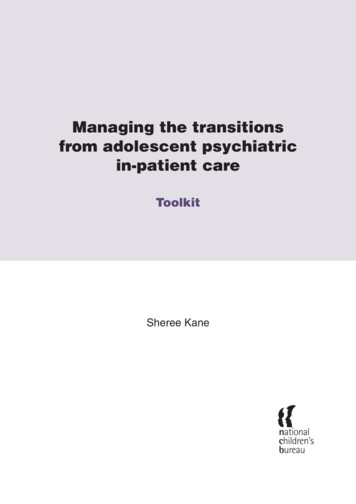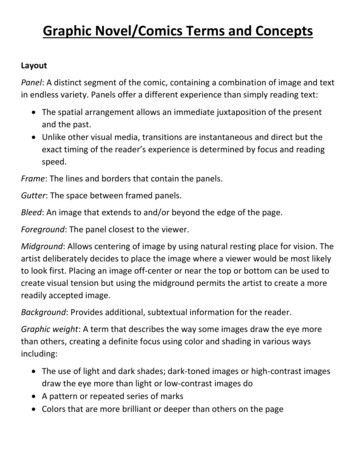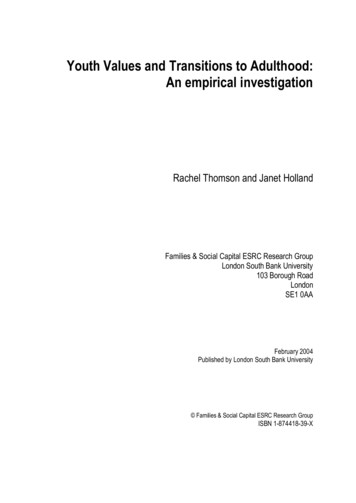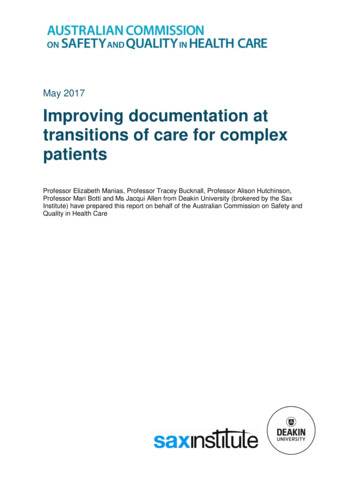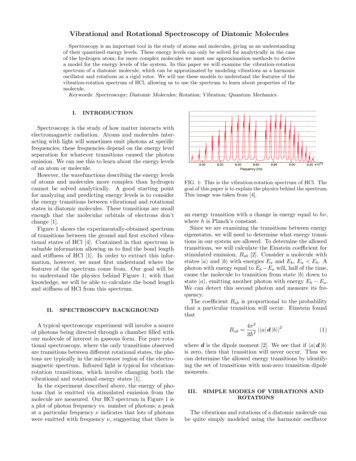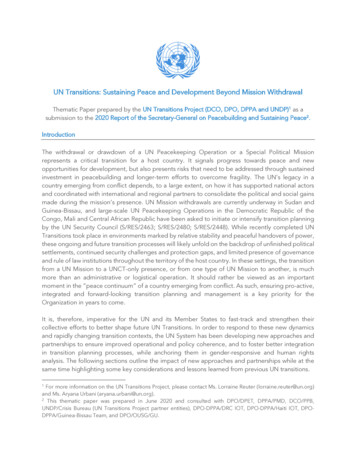
Transcription
Transitions, Transitions, Transitions:The Smoother, The Better! (Part 3)Working together to meet the challenge oftransitions in care.Hosted by The Ottawa Hospital & The Royal Ottawa HospitalMonday February 27th, 2017Villa Marconi CentreOttawa, ON
Kathryn May NPFebruary 2017Team Members:Kelly Lumley-Leger APN ManagerJulie Ann Airth NPCheryl Levi NPBarbara Torkoonoo NP
2014, CIHI
Why avoid ED Transfer? Transitions from hospital are broadly problematic for the vulnerableand frail elderly Acute care transfers are not without risk Reducing avoidable use of acute care is being addressed world wide LTC population is identified as a high cost health system user whomay be better served outside of the acute care sector Literature highlights opportunities on many levels to address“avoidable” transfers such as staffing, chronic disease management,to early detection of acute changes in condition
NLOT: Background2007: Reported ED pressures TOH responds by designing an ED NP Outreachservice to aid in addressing the urgent care needsof the LTC population2008: As part of an ED-ALC strategy the MOHestablishes a NLOT in each LHIN2012: Dr. Sinha highlights NLOT programs His comment . My Translation .
Who are we? LHIN funded program hosted by TOH with a mandateto reduce avoidable ED transfers Extension of TOH: providing outreach to LTC 4 FTE NPs working in 8 LTC Homes in Ottawa Monday to Friday coverage (0830 – 1630) Work in collaboration with LTC staff and MDs Supported by TOH ED MDs for clinical oversight
LTC Homes Carlingview Manor Glebe Centre Granite Ridge Laurier Manor Medex Perley Rideau Villa Marconi Westend Villa
Resident Age80%68%70%60%N50% 1497 resident encounters40%24%30%39%20%10%7%1%61%0% 6565-79N 1497 resident encounters80-99 100MaleFemale
What can I expect from the NP?AssessmentDiagnostic Comprehensiveadvanced healthassessment anddiagnosis POCTOrdering XR, U/S,Lab testingFacilitating CTProceduresCounselling/Education Support of PEGs,PICCs, FoleysIV therapySuturingResident & FamilyEnd of LifeAdvanced DirectivesCapacity buildingTreatment PharmacotherapyOxygenWound careRehydrationFacilitation Coordinates Econsultoutpatient clinicsSupports transitionsCollaborates withhealth care team
“Setting anexample is notthe main meansof influencingothers; it is theonly means”Albert Einstein
Encounter Outcome100%90%80%70%60%50%40%50% of EDtransferswere admitted tohospital92%30%20%8%10%0%No transferN 1497 resident encountersTransfer to ED
Key Factors for Success Collaborative LTC environment: NP is a team member Strong leadership and nursing buy-in Trust Early identification of acute changes in condition Timely response to clinical demands Evidence based care and enhanced clinical expertise ED/LTC physician support Memorandum of Understanding Monthly tracking and review of ED transfer data
NLOT: A Collaborative Partnership ED PhysiciansNLOTNPsLTCMDsLTCH Staff
Quality ImprovementProject:Reducing AntipsychoticMedication Use in LongTerm Care Homes
Spreading an Approach from the CanadianFoundation for Healthcare Improvement(CFHI) and the Executive Training forResearch Application Program (EXTRA)18
Project at a Long Term Care Home in Winnipeg Plan to reduce the inappropriate use ofantipsychotic medications Result 6 months following the initiative:– 27% of residents were taken off of their antipsychoticwithout any increase in behavioural symptoms orincreases in the use of physical restraint– Residents and families lives were improved– Front line staff were empowered19
Project Team MembersLong Term Care HomeAdministrator, DOC,RAICoordinator, BSO PSW,Medical Director, Care TeamPharmacistThe RoyalCommunityPsychiatrist, OutreachNurses, PRCResidents, Families,Family Support Boards20
Pilot Project Initially started at 35% Launch to introduce all partners to the project Binders were created to streamline the steps inthe reduction process Education Sessions were given to all staff ontopics related to Antipsychotics, and illnesses inwhich antipsychotics may be prescribed, aswell as on the tools necessary to assess, and toestablish non pharmacological approaches At Project completion was at 16% Currently at 11%21
The Process Launch to inform stakeholdersInclusion of all staffDevelop Binders with tools for projectEducation SessionsIdentification of ParticipantsObtaining ConsentThe HuddleReduction Process InitiatedMidway EvaluationSustainability22
Education CES RefresherPsychosisPIECES RefresherThe ToolsEnd of LifeMedicationsGPA RefreshersHuddlesPersonal Spaceand Safety23
Identify-Consent-Physician’s Order Identify residents prescribed antipsychoticmedications without a diagnosis ofpsychosis Obtain a consent for participation for thoseidentified Physician’s order for participation24
Getting Started Identify who will be firstGetting to Know Me in PlaceTwo per unit at one timeGo SlowlyInvolve the TeamEstablish Non PharmacologicalInterventions Evaluate and Adjust as needed25
The Huddle Weekly brainstorming sessions with the whole team – including RN,RPN, PSWs, Recreation, OT, PT, RAI Coordinator, Food and Nutrition etc. Using the P.I.E.C.E.S. model to look at the whole situation – trying tofigure out why they are displaying these behavioural symptoms. Look atthe Physical, Intellectual, Emotional, Capabilities, Environmental andSocial/Spiritual aspects to determine the possible causes.“The staff feel more empowered by what they’redoing because they can see results.”26
Moving ForwardLearning ProcessSuccesses Reduction of EPS Improved ResidentQuality of Life Staff satisfaction Staff empowerment Creativity ofCaregivers Increased TeamworkChallenges: Too Zealous Reducing tooquickly or on people whohave a diagnosis of PsychosisStaff worriedStaffing numbers toimplement nonpharmacologicalinterventionsNot looking for alternativetriggers such as a UTI forbehaviours vs antipsychoticreductionsInconsistent Accountability27
Sustainability RAI Co-Ordinator Involvement Admission Checklist HighlightingAntipsychotics and Reduction Accountability Established Re-evaluation Process Appropriate Diagnosis Continued Education Sessions Include all Partners28
Important Points to remember: Antipsychotics may be appropriate for residents with dementia ifthey are experiencing or have:- an underlying mental health condition that is being treated withantipsychotics- Delusions that are distressing to the resident- Hallucinations that are distressing to the resident- Defensive/Reactive behaviour (aggression) that is high risk- Other high risk behaviours that have not been managed successfully byother methods29
Important Points to remember: Antipsychotic drug use shows little if any benefit for the followingbehaviours:- Insomnia- Wandering- Room-entering- Pacing- Inappropriate dressing/undressing- Vocally repetitious behaviour- Hiding/collecting items- Pushing wheelchair bound co-resident- Eating inappropriate items- Trying to remove restraints30
Important Points to remember: “The goal is not to reduce antipsychotic medication to zero, but to usethis method of therapy judiciously, with caution, and whereappropriate.” “There is still a small percentage of the dementia population that maybenefit from these drugs (antipsychotics), especially for those exhibitingextreme aggression and anxiety.” “When we’re cutting down on antipsychotics, we’re cutting down onreducing falls, injuries and illness, and in the end, residents have a betterquality of life.”Schlesinger, J (2012). Formula for Success: Research project helps reduce need for medication at personal care home.31
Additional Information DE prescribing Tool – deprescribing.orgAntipsychotic (AP) Deprescribing Algorithm32
CASE REVIEWFEBRUARY 27TH, 2017www.ottawahospital.on.ca Affiliated with Affilié à
CASE 1- MR. H 72 y/o old male from home; admitted to neurosurgery with a fractured C1-2after sustaining an unwitnessed fall. PMHx: Mixed vascular dementia & Dementia with Lewy bodies (DLB),HTN, AFib, proteinuria, osteoporosis, compression #’s, obstructive sleepapnea & sleep walking. Lives with wife. Prior to admission (PTA): talking, independent withambulation, required cueing for ADLs, no incontinence.
CASE 1- MR. H CONT’D Since admission: increasing confusion, fluctuating LOC, had not been out ofbed. By day 4 of admission: received 28 mg Haldol. Referral made to the Geriatric Psychiatry Behavioural Support Team (GPBST). O/E: Pt was in a 4-point restraint, awake but difficult to understand, agitated pulling at his Aspen collar. No bowel movement x 3 days. Very rigid. Foley catheter in situ.
KEY QUESTIONS1.What are your concerns about this case?2.What do you want to know from your assessment?3.What are your thoughts about this the care of this patient?4.What would you suggest as interventions in planning care forthis patient?36
CASE 1 OUTCOMEImmediate Recommendations: D/C Haldol, reduce narcotics Reduce restraint use, implement 1:1sitter Start AChEI, Quetiapine, Trazodone, loxapine prn Initiate Bowel protocol, remove foley catheter2 Days later: More bright & alert Improved intake of food & fluids Sitting up, commode for toileting, better pain management Reduce restraint use: family & sitters Staff note easier to care for37
CASE 1 OUTCOMEWithin 1 week: Sitter and restraint use d/c’d Weaned off Seroquel, use of prn trazodone Staff education re: sleep disorder in DLB patients, pain, hunger, positioningWithin 4-6 weeks: Developed urosepsis with delirium; needing additional Seroquel prn38
CASE 1 OUTCOME3 months later Discharged to LTC after 9 weeks Not aggressive Referral made to BSO teamSeptember 2016: Return to ED with increased confusion BSO team notified acute care GPBST Avoided admission – d/c back to LTC39
CASE 2: MR. R 71-year-old male from home admitted to psychiatry after being brought to theED by police. PMHx: AFib, DM2, Vascular dementia dx1 year PTA with slow progression ofirritability, paranoia, & aggression. family hx dementia. Premorbid: Early Hx of suspiciousness, paranoia, aggressive behaviour. Lives at home with his wife who had to leave her job (Montessori teacher) tocare for him. PTA: increasing resistance to care, suspicious behaviour,wandering, wanting to drive his car. 1 week PTA took his car and got lost. Wasfound by the police. 5 months on psychiatry then transferred to Transitional Care Unit to await LTC.40
CASE 2: MR. R Referral to GPBST 6 months after admission for agitation, aggressivebehaviour, & care resistance. O/E: Incoherent speech. Nonsensical answers & mumbling. Not oriented.Poor insight, poor judgment, Parkinsonian.Care resistant , spontaneously aggressive, paranoid, wandering,poor sleep, calling out.Requiring 3 people to assist with careCurrent medications: Metformin, low dose ASA, Simvistatin, Naproxen,Mirtatzipine, Loxapine prn, Seroquel prn but getting very regularly. 41
KEY QUESTIONS1.What are your concerns about this case?2.What do you want to know from your assessment?3.What are your thoughts about this the care of this patient?4.What would you suggest as interventions in planning care forthis patient?42
CASE 2 OUTCOME Biggest priority was care resistance Supported GPA strategies: Distraction – one to talk, one to provide care Meds adjusted: Regular Seroquel (overall decrease), added trazodone Much improved sleep, more awake during the day making it much easier toprovide care. Met with family: Interests: simple coloring, drawing, Lego, puzzles, happy singing Discovered that he was the nurturer with babies when he was younger OT took GPA course: discovered doll as a substitute for interest in children Staff education & empowerment: Improved staff interaction D/C to LTC with BSO referral.43
CASE 3 MRS. A 98 y/o female to the ED with c/o irregular heart rate & confusion. EDreports negative delirium work-up. Held for GEM assessment.PMHx: AFib, HTN, COPD, hypothyroidism.Patient is a widow & has no children. Polish speaking. Lives with niece &her husband (who are in their 70’s) who provide all IADL support. Hassome CCAC support for bathing & respite.Family report “fine until fall down stairs 3 months ago” when she wasadmitted with vertebral fractures. Since d/c has become more irritable &argumentative. Poor intake of food and fluids. X 3 days accusing them ofchanging her pills, yelling & screaming but does not remember episodes.Meds: Oxazepam, Citalopram, diltiazem, furosemide, levothyroxine, K O/E: Anxious , tearful, distraught, passive SI, Able to providereasonable hx, no obvious cognitive concerns44
KEY QUESTIONS1.What are your concerns about this case?2.What do you want to know from your assessment?3.What are your thoughts about this the care of this patient?4.What would you suggest as interventions in planning care forthis patient?45
CASE 3 OUTCOME Support for family; reassurance for patient. Discovered error in oxazepam dosage from previous discharge. D/C oxazepam, start mirtazepine, trazodone. Patient settled & was d/c home from the ED.2 months later: ED visit for unrelated concern. Still living with niece but with regularly scheduled respite care; improvedmood, ambulating with 4 wheeled walker. Family reports great improvement in quality of life.46
Weekly brainstorming sessions with the whole team - including RN, RPN, PSWs, Recreation, OT, PT, RAI Coordinator, Food and Nutrition etc. Using the P.I.E.C.E.S. model to look at the whole situation - trying to figure out why they are displaying these behavioural symptoms. Look at




